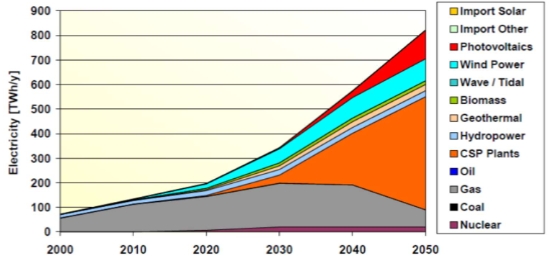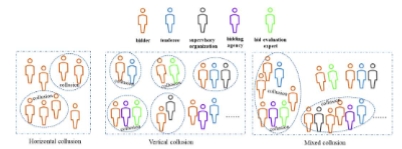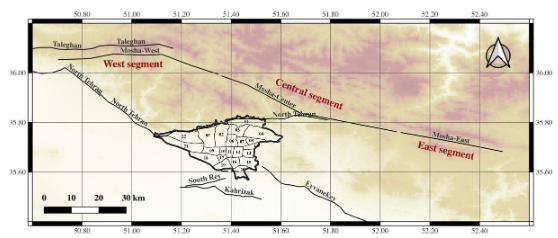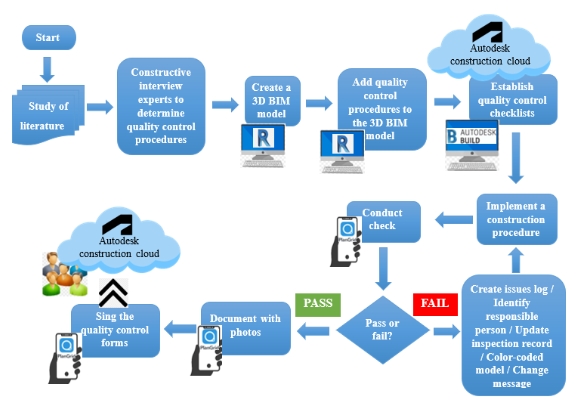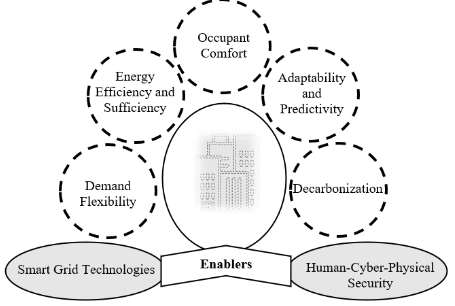Impact of activity time stochasticity on critical paths and their completion probabilities in construction projects
Abstract
Accurate planning and project control activities are essential in ensuring the timely completion of construction projects. Even though the classical scheduling techniques like Gantt charts, critical path method (CPM), program evaluation and review technique (PERT), etc., are well-designed and can effectively support construction scheduling functions, they do not account for the variability in activity times arising out of the random/stochastic nature of the activities involved. The study utilizes a simulation-based approach to identify the impact of variability in activity time durations on critical paths and on the probability of timely completion of construction projects. The effectiveness of four different probability distribution functions, namely uniform, triangular, bound exponential, and unbound exponential, in capturing the stochasticity of activity times in construction projects was also evaluated as part of the study. A MATLAB-based simulation framework was developed to sample random durations of project activities and compute various project scheduling parameters based on PERT assumptions. Activity time variability was introduced in the network by extending pessimistic time (tp) by up to 50%. Observation in the study suggests that for projects that experience delays during execution, allocating additional resources to the preassigned critical path may not always be effective in addressing these delays. Instead, dynamic corrective measures (time extensions, resource allocation, etc.) that consider all possible scenarios of project completion and can account for any possible changes in critical path due to the incurred delay may be adopted to ensure a higher probability of project completion within the revised schedule. Exponential bounded distribution was found to provide a more realistic estimate of project completion time with a high probability of timely completion of construction projects. The study also suggests exponential unbound distribution to be effective in simulating worst-case scenarios encountered in construction projects. Future research could validate this approach on real projects and use machine learning to automate scheduling adjustments for delays.
References
[1]Rose KH. A Guide to the Project Management Body of Knowledge (PMBOK Guide) Fifth Edition. Project Management Journal. 2013; 44(3). doi: 10.1002/pmj.21345
[2]Kerzner H. Project Management: A systems approach to planning, scheduling and control, 10th Ed. Industrial Engineering/Project Management; 2010.
[3]Lester EIA. Project Management. Project Management, Planning and Control. Butterworth-Heinemann; 2014.
[4]Nicholas JM, Steyn H. Project Management for Engineering, Business and Technology. Routledge; 2020.
[5]González-Cruz M-C, Ballesteros-Pérez P, Lucko G, et al. Critical Duration Index: Anticipating Project Delays from Deterministic Schedule Information. Journal of Construction Engineering and Management. 2022; 148(11). doi: 10.1061/(ASCE)CO.1943-7862.0002387
[6]Khamooshi H, Cioffi DF. Uncertainty in Task Duration and Cost Estimates: Fusion of Probabilistic Forecasts and Deterministic Scheduling. Journal of Construction Engineering and Management. 2013; 139(5): 488-497. doi: 10.1061/(ASCE)CO.1943-7862.0000616
[7]Zhang S, Song X, Shen L, et al. Complicated Time-Constrained Project Scheduling Problems in Water Conservancy Construction. Processes. 2023; 11(4): 1110. doi: 10.3390/pr11041110
[8]Olawale YA, Sun M. Cost and time control of construction projects: inhibiting factors and mitigating measures in practice. Construction Management and Economics. 2010; 28(5): 509-526. doi: 10.1080/01446191003674519
[9]Gupta S, George RC, Philip D, et al. Activity Time Variations and Its Influence on Realization of Different Critical Paths in a PERT Network: An Empirical Study Using Simulations. In: Proceedings of the 2nd International Civil Engineering and Architecture Conference; 11-14 March 2022; Singapore.
[10]Malcolm DG, Roseboom JH, Clark CE, et al. Application of a Technique for Research and Development Program Evaluation. Operations Research. 1959; 7(5): 646-669. doi: 10.1287/opre.7.5.646
[11]Sculli D. A historical note on PERT times. Omega. 1989; 17(2):195-196. doi: 10.1016/0305-0483(89)90011-X
[12]Dodin B. Approximating the distribution functions in stochastic networks. Computers & Operations Research. 1985; 12(3): 251-264. doi: 10.1016/0305-0548(85)90024-3
[13]Dodin B, Sirvanci M. Stochastic networks and the extreme value distribution. Computers & Operations Research. 1990; 17(4): 397-409. doi: 10.1016/0305-0548(90)90018-3
[14]Tesfaye E, Girma K, Berhan E, et al. A simulation of project completion probability using different probability distribution functions. Advances in Intelligent Systems and Computing. 2015; 334: 133–145. doi: 10.1007/978-3-319-13572-4_11
[15]Thompson RC, Lucko G, Su Y. Reconsidering an Appropriate Probability Distribution Function for Construction Simulations. Construction Research Congress 2016; 2016.
[16]Hahn ED, Martin MDML. Robust project management with the tilted beta distribution. Maryland Shared Open Access Repository; 2015.
[17]Lau HS, Somarajan C. A proposal on improved procedures for estimating task-time distributions in PERT. European Journal of Operational Research. 1995; 85(1): 39-52. doi: 10.1016/0377-2217(93)E0213-H
[18]Premachandra IM. An approximation of the activity duration distribution in PERT. Computers & Operations Research. 2001; 28(5): 443-452. doi: 10.1016/S0305-0548(99)00129-X
[19]Badiru AB. A simulation approach to PERT network analysis. SIMULATION. 1991; 57(4): 245-255. doi: 10.1177/003754979105700409
[20]Lee DE, Arditi D, Son CB. The probability distribution of project completion times in simulation-based scheduling. KSCE Journal of Civil Engineering. 2013; 17(4): 638-645. doi: 10.1007/s12205-013-0147-x
[21]Salas-Morera L, Arauzo-Azofra A, García-Hernández L, et al. New Approach to the Distribution of Project Completion Time in PERT Networks. Journal of Construction Engineering and Management. 2018; 144(10). doi: 10.1061/(ASCE)CO.1943-7862.0001552
[22]Williams FE. PERT Completion Times Revisited. INFORMS Transactions on Education. 2005; 6(1): 21-34. doi: 10.1287/ited.6.1.21
[23]Yao MJ, Chu WM. A new approximation algorithm for obtaining the probability distribution function for project completion time. Computers & Mathematics with Applications. 2007; 54(2): 282-295. doi: 10.1016/j.camwa.2007.01.036
[24]Mohan S, Gopalakrishnan M, Balasubramanian H, et al. A lognormal approximation of activity duration in PERT using two time estimates. Journal of the Operational Research Society. 2007; 58(6): 827-831. doi: 10.1057/palgrave.jors.2602204
[25]Hajdu M, Bokor O. The Effects of Different Activity Distributions on Project Duration in PERT Networks. Procedia - Social and Behavioral Sciences. 2014; 119: 766-775. doi: 10.1016/j.sbspro.2014.03.086
[26]Khan IA, Bickel JE, Hammond RK. Determining the Accuracy of the Triangular and PERT Distributions. Decision Analysis. 2023; 20(2): 151-165. doi: 10.1287/deca.2022.0464
[27]Parks WH, Ramsing KD. The Use of the Compound Poisson in Pert. Management Science. 1969; 15(8): B-397-B-402. doi: 10.1287/mnsc.15.8.b397
[28]Abdelkader YH. Evaluating project completion times when activity times are Weibull distributed. European Journal of Operational Research. 2004; 157(3): 704-715. doi: 10.1016/S0377-2217(03)00269-8
[29]Hahn ED. Mixture densities for project management activity times: A robust approach to PERT. European Journal of Operational Research. 2008; 188(2): 450-459. doi: 10.1016/j.ejor.2007.04.032
[30]Pérez JG, Martín M del ML, García CG, et al. Project management under uncertainty beyond beta: The generalized bicubic distribution. Operations Research Perspectives. 2016; 3: 67-76. doi: 10.1016/j.orp.2016.09.001
[31]Lee D-E. Stochastic Project Scheduling Simulation System (SPSS III). Korean Journal of Construction Engineering and Management. 2005; 6: 73-79
[32]Lee D-E, Yi C-Y, Lim T-K, et al. Integrated Simulation System for Construction Operation and Project Scheduling. Journal of Computing in Civil Engineering. 2010; 24(6): 557-569. doi: 10.1061/(ASCE)CP.1943-5487.0000061
[33]Golenko-Ginzburg D. On the Distribution of Activity Time in PERT. Journal of the Operational Research Society. 1988; 39(8): 767-771. doi: 10.1057/jors.1988.132
[34]Alagheband A. An efficient algorithm for calculating the exact overall time distribution function of a project with uncertain task durations. Indian Journal of Science and Technology. 2012; 5(9): 1-7. doi: 10.17485/ijst/2012/v5i9.20
[35]Kleindorfer GB. Bounding Distributions for a Stochastic Acyclic Network. Operations Research. 1971; 19(7): 1586-1601. doi: 10.1287/opre.19.7.1586
[36]Mehrotra K, Chai J, Pillutla S. A study of approximating the moments of the job completion time in PERT networks. Journal of Operations Management. 1996; 14: 277-289. doi: 10.1016/0272-6963(96)00002-2
[37]Soroush HM. The Most Critical Path in a PERT Network. Journal of the Operational Research Society. 1994; 45(3): 287-300. doi: 10.1057/jors.1994.42
[38]Soroush HM. The most critical path in a PERT network: A heuristic approach. European Journal of Operational Research. 1994; 78(1): 93-105. doi: 10.1016/0377-2217(94)90124-4
[39]Lee D-E. Probability of Project Completion Using Stochastic Project Scheduling Simulation. Journal of Construction Engineering and Management. 2004; 131(3): 310-318. doi: 10.1061/(ASCE)0733-9364(2005)131:3(310)
[40]Lee DE, Bae TH, Arditi D. Advanced Stochastic Schedule Simulation System. Civil Engineering and Environmental Systems; 2011.
[41]Ahuja HN, Dozzi SP, AbouRizk SM. Project management: techniques in planning and controlling construction projects. Wiley India; 1994.
[42]Hillier FS, Lieberman GJ. Introduction to operations research, ELEVENTH. McGraw Hill; 2021.
[43]Pinedo ML. Planning and Scheduling in Manufacturing and Services, 2nd ed. Springer-Verlag New York; 2000.
[44]Winston WL. Operations Research: Applications and Algorithms. Cengage Learning; 2022.
[45]Hajdu M. Effects of the application of activity calendars on the distribution of project duration in PERT networks. Automation in Construction. 2013; 1(35): 397-404.
[46]Zohrehvandi S. A Project-Scheduling and Resource Management Heuristic Algorithm in the Construction of Combined Cycle Power Plant Projects. Computers. 2022; 11(2): 23. doi: 10.3390/computers11020023
[47]Hajdu M, Bokor O. Sensitivity analysis in PERT networks: Does activity duration distribution matter? Automation in Construction. 2016; 65: 1-8. doi: 10.1016/j.autcon.2016.01.003
[48]Mályusz L, Vattai Z. Project scheduling algorithms for construction projects with stretchable activities. IOP Conference Series: Materials Science and Engineering. 2022; 1218(1): 012043. doi: 10.1088/1757-899x/1218/1/012043
[49]Wang J, Liu H, Wang Z. Stochastic Project Scheduling Optimization for Multi-stage Prefabricated Building Construction with Reliability Application. KSCE Journal of Civil Engineering. 2023; 27(6): 2356-2371. doi: 10.1007/s12205-023-2164-8
[50]Ansar A, Flyvbjerg B, Budzier A, et al. Does infrastructure investment lead to economic growth or economic fragility? Evidence from China. Oxford Review of Economic Policy. 2016; 32(3): 360-390. doi: 10.1093/oxrep/grw022
[51]Cantarelli CC, Flyvbjerg B, Molin EJE, et al. Cost Overruns in Large-scale Transportation Infrastructure Projects: Explanations and Their Theoretical Embeddedness. European Journal of Transport and Infrastructure Research; 2010.
[52]Ellis RD, Thomas HR. The root causes of delays in highway construction. In: Proceedings of the 82nd Annual Meeting of the Transportation Research Board; 2002; Washington, D.C.
[53]Salhab D, Lindhard SM, Hamzeh F. Simulation-Based Approximation of the Gain from Applying Overlapping Activities. Journal of Construction Engineering and Management. 2024; 150(4). doi: 10.1061/jcemd4.coeng-14166
[54]Révész P. The laws of large numbers. Academic Press; 1968.
[55]Salhab D, Møller DE, Lindhard SM, et al. Accounting for Variability: Identifying Critical Activities as a Supplement to the Critical Path. Journal of Construction Engineering and Management. 2022; 148(5). doi: 10.1061/(ASCE)CO.1943-7862.0002266
[56]MoSPI G of I. FLASH REPORT ON (Rs. 150 crore and above). Government of India Ministry of Statistics and Programme Implementation Infrastructure and Project Monitoring Division; 2020.
[57]Gupta S, George RC, Philip D, et al. Data-Driven Decision Framework for Modeling and Quantification of Uncertainty and Variability in Construction Project Scheduling. Journal of Structural Design and Construction Practice ASCE. 2024. doi: 10.1061/JSDCCC/SCENG-1817
Copyright (c) 2025 Author(s)

This work is licensed under a Creative Commons Attribution 4.0 International License.





